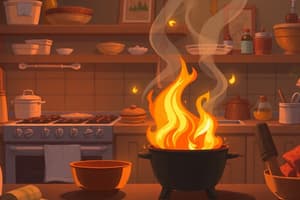Podcast
Questions and Answers
True or false: The #1 rule in kitchen safety is to not do anything without Mrs. Maggie's permission.
True or false: The #1 rule in kitchen safety is to not do anything without Mrs. Maggie's permission.
True (A)
True or false: If something spills in the kitchen, it is important to tell everyone and clean up.
True or false: If something spills in the kitchen, it is important to tell everyone and clean up.
True (A)
True or false: Flammable items cannot catch fire easily.
True or false: Flammable items cannot catch fire easily.
False (B)
Mention the protective clothing:
Mention the protective clothing:
Parts of fire extinguisher: ______
Parts of fire extinguisher: ______
Flammable: can get fire ____________
Flammable: can get fire ____________
What are the steps to use a fire extinguisher?
What are the steps to use a fire extinguisher?
What are some examples of protective clothing needed in the kitchen?
What are some examples of protective clothing needed in the kitchen?
True or false: Flammable items cannot catch fire easily.
True or false: Flammable items cannot catch fire easily.
Flashcards
Kitchen Rule #1
Kitchen Rule #1
The #1 rule in kitchen safety is to not do anything without Mrs. Maggie's permission.
Spill Protocol
Spill Protocol
If something spills in the kitchen, it is important to tell everyone and clean it up immediately to prevent accidents.
Flammable
Flammable
Items that catch fire easily are considered flammable.
Protective Kitchen Clothing
Protective Kitchen Clothing
Signup and view all the flashcards
Fire Extinguisher Parts
Fire Extinguisher Parts
Signup and view all the flashcards
Fire Extinguisher Steps
Fire Extinguisher Steps
Signup and view all the flashcards
Study Notes
Kitchen Safety Rules
- Always seek permission from Mrs. Maggie before performing tasks in the kitchen for safety compliance.
- Report spills immediately and ensure thorough cleanup to prevent accidents and injuries.
- Flammable items can easily catch fire; handle them with care.
Fire Safety Equipment
- Key parts of a fire extinguisher include:
- Pressure gauge
- Handle
- Nozzle
- Base (support)
- Flammable materials can ignite quickly, necessitating safe storage and handling practices.
Fire Extinguisher Usage Steps
- Pull: Pull the pin on the fire extinguisher to break the seal.
- Aim: Aim the nozzle at the base of the fire.
- Squeeze: Squeeze the handle to release the extinguishing agent.
- Sweep: Sweep the nozzle from side to side until the fire is completely out.
Protective Clothing in the Kitchen
- Aprons to protect clothing from spills and stains.
- Heat-resistant gloves to handle hot pots and pans.
- Non-slip shoes to ensure a stable footing and reduce fall risks.
- Hairnets to keep hair secured and prevent contamination.
Studying That Suits You
Use AI to generate personalized quizzes and flashcards to suit your learning preferences.




